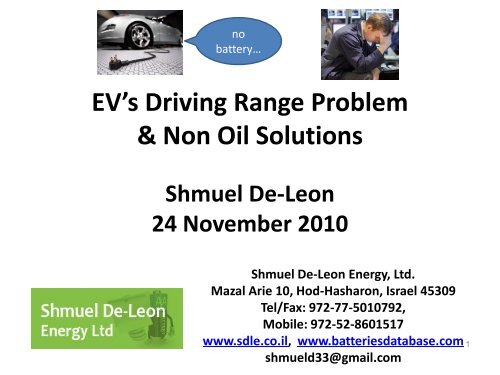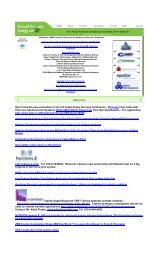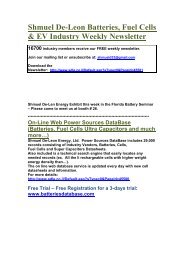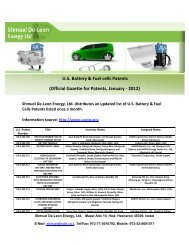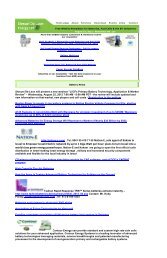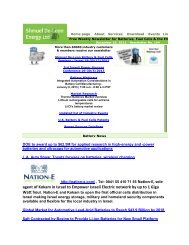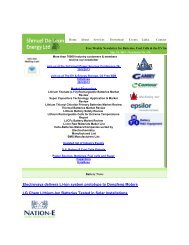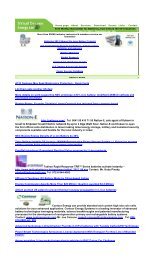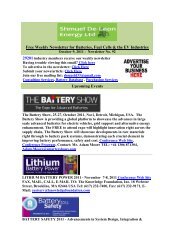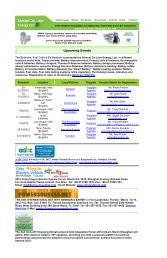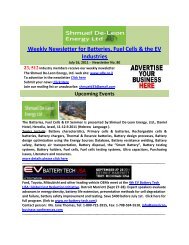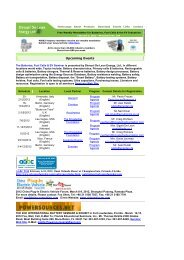EV's Driving Range Problem - Shmuel De-Leon Energy
EV's Driving Range Problem - Shmuel De-Leon Energy
EV's Driving Range Problem - Shmuel De-Leon Energy
You also want an ePaper? Increase the reach of your titles
YUMPU automatically turns print PDFs into web optimized ePapers that Google loves.
no<br />
battery…<br />
EV’s <strong>Driving</strong> <strong>Range</strong> <strong>Problem</strong><br />
& Non Oil Solutions<br />
<strong>Shmuel</strong> <strong>De</strong>-<strong>Leon</strong><br />
24 November 2010<br />
<strong>Shmuel</strong> <strong>De</strong>-<strong>Leon</strong> <strong>Energy</strong>, Ltd.<br />
Mazal Arie 10, Hod-Hasharon, Israel 45309<br />
Tel/Fax: 972-77-5010792,<br />
Mobile: 972-52-8601517<br />
www.sdle.co.il, www.batteriesdatabase.com<br />
shmueld33@gmail.com<br />
1
<strong>Shmuel</strong> <strong>De</strong>-<strong>Leon</strong> <strong>Energy</strong>, Ltd.<br />
• A new power sources Knowledge Company<br />
founded on 2010.<br />
- Consulting services.<br />
- Battery & Fuel Cells seminars.<br />
- Weekly newsletters.<br />
- Power sources DataBase.<br />
- Battery solutions.<br />
<strong>Shmuel</strong> <strong>De</strong>-<strong>Leon</strong> <strong>Energy</strong>, Ltd.<br />
Where Knowledge and vision<br />
take place<br />
2
Electric Vehicles – A Growing Market<br />
E-transportation –<br />
most significant<br />
technological<br />
revolution after the<br />
cellular and the<br />
internet.<br />
3
Current Battery Technology Satisfies Small<br />
Urban <strong>Driving</strong> EV’s<br />
Reva<br />
Mega<br />
Think<br />
Urban small EV’s are not expected to drive long distances.<br />
Current batteries technology provide a satisfy energy<br />
needed for urban driving distance – slow charging done at<br />
home during night.<br />
4
EV <strong>Driving</strong> <strong>Range</strong> <strong>Problem</strong><br />
• ICE vehicles – No driving range problem.<br />
• Current EV battery technology:<br />
- 80-100 WH/kg on battery level<br />
- Common 25–42kWh battery<br />
- 500-1000$/kWh cost<br />
- Charging time of 30min to 8hr<br />
- Estimate limited battery life of 75-150k km<br />
- Average EV a maximum driving range of 160 km<br />
Will the drivers accept driving range limitations?<br />
At what reduced cost?<br />
Can the EV industry provide reduced cost with a high battery cost?<br />
5
Why Batteries Are Not Providing The<br />
<strong>Driving</strong> <strong>Range</strong> Needed?<br />
<strong>Energy</strong> <strong>De</strong>nsity (WH/Kg) = EV <strong>Driving</strong> <strong>Range</strong> (km)<br />
6
Battery is the <strong>Problem</strong> - Technology<br />
Breakthrough Urgently Needed<br />
The targets:<br />
- > 500wh/kg at battery level<br />
- Ultra fast charging > 10C<br />
- > 2500 full D.O.D cycles<br />
7
II & III Generation - Li-Ion High <strong>Energy</strong><br />
<strong>De</strong>nsity Batteries<br />
• NCA, NMP, LPF<br />
• 5v spinal/Graphite Systems<br />
• HE-LMO/Graphite<br />
• HE-LMO/Si-C<br />
• New development of High Voltage new Li-Ion<br />
batteries promise up to 25% increase on <strong>Energy</strong><br />
<strong>De</strong>nsity on the next 2-4 years.<br />
• Fast charging, Cycle life, Safety & Cost are still an<br />
issue.<br />
8
Lithium Metal Rechargeable batteries<br />
High potentially theoretical energy density + Very Low cost raw materials<br />
Make it an ideal battery system for EV’s<br />
But Cycle Life , Safety and Fast Charging are the limiter…
DBM <strong>Energy</strong>'s - KOLIBRI AlphaPolymer<br />
- German Company claim to develop a breakthrough Lithium Metal<br />
rechargeable battery for EV with:<br />
- Li-Fe-Poly (260 Ah/380 V) cell voltage of 3.8 volts<br />
- 300 WH/Kg<br />
- 2500 Cycles<br />
- 6 min full ultra fast charge<br />
2010 Audi A2 travels 375 miles on a single charge equipped with DBM<br />
Battery tech.<br />
http://www.dbm-energy.com/
Oil <strong>De</strong>pendant Mid-Term Solutions<br />
HEV – uses oil and batteries to operate parallel ICE and E-Engines (ICE<br />
charge the battery during driving – no external charger).<br />
PHEV – (Parallel E-Engine) – battery operates E-engine, when battery<br />
depletes, an ICE will provide extra range using oil and the battery<br />
can also be recharged by an external charger.<br />
PHEV (EREV) – (Serial E-engine) - battery operates E-engine; when<br />
battery depletes, a small ICE or turbine recharges the battery and<br />
provides electricity to the E-Engine using oil and the battery can also<br />
be recharged by an external charger.<br />
Chevrolet Volt<br />
ETV Motors<br />
11
Fuel Cell EV<br />
- FC provides higher energy density than batteries (>500 Wh/Kg).<br />
- Refueling with hydrogen gas or liquid fuels is simple.<br />
- No grid impact.<br />
- FCEV technology is in a development phase, Some pilot<br />
projects are currently being tested.<br />
- FC may be the leading EV energy source technology at the long<br />
term.<br />
Hydrogen Filling Station 12
Metal Air Batteries<br />
- MA systems like Li-air, Zinc-air, Al-air, Si-Air are under development.<br />
- MA battery energy density (>500 WH/Kg).<br />
- Refueling the system is done by replacing the metal anode and the<br />
electrolyte – no impact on the grid.<br />
- Future systems may be able to recharge electrically.<br />
- Extra development is needed – some disclose projects are very<br />
promising.<br />
Lithium-Air cell<br />
Revolt Rechargeable<br />
Zinc-Air Technology<br />
13
Bi-Polar Plate Li-Air Battery<br />
* Ford Li-Air research<br />
14
APET (Taiwan) Zinc- Air Battery<br />
- Zinc filled pouch cells are assembled to a 30kWh battery and fit as<br />
an extra range energy source for EV, provide extra 300km driving<br />
range before zinc replaced.<br />
- The EV also uses a 10 kWh NiMh main power battery.<br />
- No need for a plug-in recharge.<br />
www.salamanderian.com<br />
15
Leo Motors – Zinc-Air <strong>Range</strong> Extender<br />
- Korean Company shows 2 electric trucks using Zinc-Air fuel cells<br />
with a 140 miles driving range.<br />
- ZAFC is a generator refueled by using small zinc pellets and by using<br />
an easily removed chamber.<br />
- ZAFC charged the EV battery.<br />
www.leomotors.com<br />
16
Switch EV Batteries<br />
• A feasible current technology solution use current battery<br />
technology.<br />
• Industry dilemmas:<br />
- Will the EV makers design their car to use switch batteries?<br />
- Will the EV industry accept standard switch batteries that can be<br />
switched at universal battery switch stations, or should a special<br />
switch station should be designed for each EV model?<br />
- is the cost too expansive?<br />
17
Electric Buses switch Batteries Project<br />
• 50 switch EV battery buses deployed in the Olympic village in Beijing.<br />
• Maximal driving range of 130 km and a maximum speed of 50<br />
km/h.<br />
• Batteries slow recharge during night – 6 hours charge.<br />
• The project prove the switch battery concept but fail prove to be an<br />
economic solution.<br />
Following the proof of concept - Mitsubishi Heavy Industries to<br />
Experiment With Switchable Battery Electric Buses (April 2010)<br />
18
Better Place Switch Batteries Project<br />
• Better Place developed a switch EV battery driving range solution to<br />
be used with Renault EV’s.<br />
• First pilot electric taxi project recently started in Japan.<br />
• Cost is an issue? - Can Better Place provide the solution at a<br />
reasonable cost?<br />
19
Chinese EV makers <strong>De</strong>monstrate SWAP<br />
Technology – 2010 Beijing<br />
Chery Automobile , BAIS, IAT<br />
The legitimacy of the switch batteries as a leading solution<br />
become more strong as a new player use that solution<br />
20
Quick Charge Batteries<br />
• Some EV makers believe that QC in 30min, 80% of battery<br />
capacity can be the mid term solution.<br />
• QC can be done with “Standard Li-Ion batteries” – no need to<br />
develop new batteries.<br />
• But many believe that an average driver will not accept a waiting<br />
time of 30 min to charge batteries on long range driving every 120<br />
km.<br />
Epyon<br />
Fast<br />
Charger<br />
21
Ultra Fast Charging EV Batteries<br />
• UFC battery technology - up to 5 min, >80% capacity - available<br />
today but with a painful low energy density 60-80 WH/Kg & HIGH<br />
COST.<br />
• Some promising development projects should increase energy<br />
densities, cycle life and safety.<br />
• Electricity grid effect is also a place for concern.<br />
Some of the UFC cells and developing companies<br />
Cell I.D Wh/Kg Charge Rate Cycle Life<br />
Toshiba SCiB 65 11.9C 6000<br />
Altairnano<br />
No Data<br />
Enerdel<br />
Saft<br />
Actacell<br />
22
Think EV Fast Charging Solution<br />
• Think announced that it will work with AeroVironment, inc to<br />
develop FC infrastructure.<br />
• Targeting to charge the EV battery from 0-80% capacity in just 15<br />
min (Ener<strong>De</strong>l Battery – 345v, 80ah, up to 160 km driving range).<br />
• Most of the time, batteries will be charge on slow charge but when<br />
an extra range will be needed the driver can use UFC in road<br />
charging stations (DC off board 50kW charger).
BYD EV Fast Charging Solution<br />
• BYD e6 is an all-electric crossover car that is claimed to deliver<br />
300 km (186 mi) with one charge – 72KWh battery.<br />
• BYD announced that the e6 it will be charged to 80% in 20 min<br />
with own made fast chargers.
Japan Firm to Standardize EV Fast charge<br />
• Top Japanese carmakers Toyota and Nissan helped set up a group to<br />
standardize fast-charge stations for electric cars.<br />
• The group, led by Japan's biggest utility, Tokyo Electric Power Co<br />
(TEPCO), Toyota Motor Corp, Nissan Motor Co, Mitsubishi Motors<br />
Corp and Fuji Heavy Industries Ltd, will set a standard for Japan and<br />
later aim for an international standard.<br />
• Many world wide companies joined.<br />
• Forming a common "language" for fast-charging electric cars across<br />
various brands would save development costs for carmakers and<br />
ancillary industries.<br />
CHAdeMO Council
What some EV market player says…<br />
Swap Technology<br />
Fast Charge<br />
2-5C<br />
Quick Charge<br />
2C<br />
Standard charge<br />
0.1-1C<br />
Better Place -<br />
Renault Fluence<br />
Renault Kangoo<br />
Renault Zoe<br />
Chery<br />
IAT<br />
BAIC<br />
Think (O)<br />
BYD<br />
BMW<br />
Hyundai (i10)<br />
Phoenix (SUT, SUV)<br />
Subaru (R1e Stella)<br />
Zenn (CITYZenn)<br />
Mitsubishi (MIEV)<br />
Peugeot (iOn)<br />
Nissan (Leaf)<br />
Renault (Fluence,<br />
Kangoo)<br />
Chery (S18)<br />
Pininfarina (aka B0)<br />
TATA (S)<br />
Coda (sedan),<br />
Commuter (Tango,<br />
Toyota (FT)<br />
CT&T<br />
There is a place to all the solutions –<br />
The customers will choose the best<br />
for them<br />
26
Summery<br />
• Current batteries are not providing the energy density, Cycles, Fast<br />
charge needed for the EV driving range needs.<br />
• New battery technologies like Li-Ion II & III generation or Lithium<br />
Metal systems may increase driving ranges up to 25% on the next<br />
2-4 years.<br />
• Lower oil dependent solutions like HEV and PHEV should be a mid<br />
term solution.<br />
• Battery swapping is a potential current-mid term solution for BEV.<br />
• Ultra fast Charging Technology still not feasible but some new<br />
promising development (Nano & Titanate) will assure it as a mid<br />
term solution (2-5 years).<br />
• Fuel Cells & Metal Air system are candidate solutions on the long<br />
term (5-10 years).<br />
Technology progress along with safety & cost<br />
27<br />
reduction is the key for success
Summery<br />
• The power source side is not the only factor – EV’s maker should<br />
manufacture more efficient vehicles with lower power<br />
consumption.<br />
• Improvements on the Vehicle side will also contribute for extended<br />
driving range.<br />
Technology progress along with safety & cost<br />
reduction is the key for success<br />
28
Thank you for your attention<br />
<strong>Shmuel</strong> <strong>De</strong>-<strong>Leon</strong> <strong>Energy</strong>, Ltd.<br />
Mazal Arie 10, Hod-Hasharon, Israel 45309<br />
Tel/Fax: 972-77-5010792, Mobile: 972-52-8601517<br />
www.sdle.co.il, www.batteriesdatabase.com<br />
shmueld33@gmail.com<br />
Information on that presentation obtained by:<br />
1. Public web sources.<br />
2. <strong>Shmuel</strong> de-leon Battery /<strong>Energy</strong> Sources DataBase ® (Includes 28000 cells<br />
PDF data sheets ).<br />
3. <strong>Shmuel</strong> <strong>De</strong>-<strong>Leon</strong> Batteries & Fuel cells Seminar ® presentations.<br />
29


